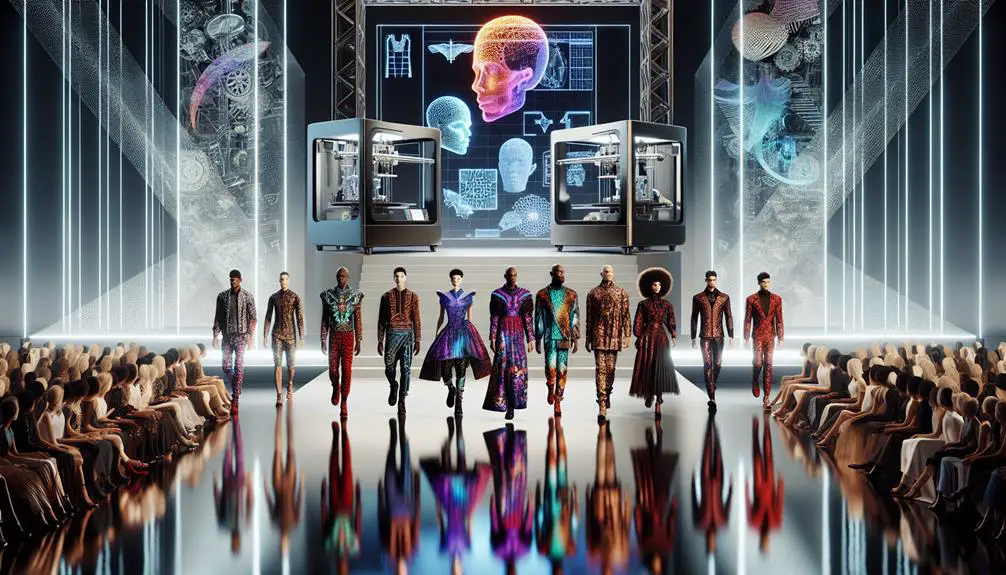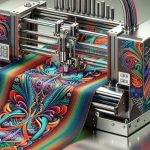Discover how 3D printing is shaking up the fashion industry. You're now able to create intricate designs and textures that were once impossible. It's also great for the planet because it cuts down on waste and promotes the use of eco-friendly materials. Plus, you can customize garments to fit perfectly, using body scanning and virtual tailoring. Designers love it as they can swiftly bring innovative ideas to life, staying ahead of trends. While there are challenges, like high costs and limited materials, the future looks promising. Learn what's on the horizon for 3D printed textiles and fashion.
Table of Contents
Key Takeaways
- 3D printing allows for highly customizable and precise garment fitting using body scanning and virtual tailoring.
- The technology supports sustainable fashion through on-demand production and significant waste reduction.
- Enhanced design flexibility facilitates the creation of intricate, innovative, and unique textile patterns and textures.
- The use of eco-friendly and recycled materials in 3D printing contributes to a reduced environmental impact.
- Despite high initial costs, 3D printing democratizes high-quality, tailored fashion, making it accessible to a broader audience.
Evolution of 3D Printing
3D printing has come a long way since its inception in the 1980s, transforming from a niche technology into a mainstream tool. You might be amazed at how this technology has evolved over the years. Initially, 3D printing was limited to creating simple plastic models. However, thanks to continuous evolutionary advancements, the capabilities have expanded dramatically.
Technological breakthroughs have played a pivotal role in this progression. Early 3D printers were slow and expensive, often restricted to industrial use. Today, they're faster, more affordable, and can work with various materials including metals, ceramics, and even bio-materials. These advancements have made 3D printing accessible to hobbyists, educators, and small businesses, not just large corporations.
You've also seen improvements in precision and detail. Modern 3D printers can produce intricate designs with high accuracy, making them invaluable for various applications. Software advancements have further simplified the design process, allowing you to create complex models with ease.
Understanding the evolutionary advancements and technological breakthroughs in 3D printing equips you to leverage this powerful tool effectively. Whether you're a beginner or looking to deepen your expertise, staying updated with these changes can help you master the art of 3D printing.
Benefits for Designers
With 3D printing, you can enjoy greater design flexibility, making your creative visions easier to bring to life.
You'll also benefit from more sustainable production methods, reducing waste and promoting eco-friendly practices.
Plus, the technology allows for unmatched customization and personalization, letting you cater to individual tastes and needs.
Enhanced Design Flexibility
Imagine having the freedom to bring any intricate design or pattern to life without the constraints of traditional textile methods. That's exactly what 3D printing offers you. With 3D printing, you're not limited by the usual boundaries, allowing for unparalleled design innovation. You can experiment with shapes, textures, and patterns that were previously impossible or extremely difficult to achieve. This enhanced flexibility means you can push your creative boundaries and explore new artistic directions.
Think about the creative freedom you gain. Want to design a dress with a complex geometric pattern or a fabric that mimics natural textures? No problem. 3D printing lets you realize these visions with precision and ease. Plus, you can prototype rapidly, tweak designs on the fly, and produce unique, one-of-a-kind pieces without the laborious processes associated with traditional methods.
In the world of fashion, where trends change rapidly and uniqueness is prized, this capability is a game-changer. You can stay ahead of trends, create custom designs for clients, and truly set yourself apart in a crowded market.
Embrace the future and let 3D printing take your textile designs to the next level.
Sustainable Production Methods
Adopting sustainable production methods in textile design not only helps the environment but also boosts your creative process and brand appeal. By embracing 3D printing, you can achieve ethical sourcing and waste reduction, two critical aspects of modern fashion. You'll find that sustainable practices don't just protect the planet; they open up new avenues for innovation.
Here's a quick overview of the benefits:
| Benefit | How It Works | Why It Matters |
|---|---|---|
| Ethical Sourcing | Materials from responsible suppliers | Enhances brand credibility |
| Waste Reduction | Precise material use through 3D printing | Cuts down on excess and costs |
| Circular Economy | Reusable and recyclable materials | Promotes long-term sustainability |
| Design Innovation | Freedom to experiment with new forms | Sparks unique and marketable designs |
| Consumer Appeal | Attracts eco-conscious customers | Expands your market reach |
Customization and Personalization
3D printing lets you effortlessly customize and personalize textile designs, offering endless possibilities for creativity and uniqueness. As a designer, you can tap into this technology to create bespoke options tailored to your clients' exact needs. Imagine being able to produce individualized styles that perfectly match someone's personality and preferences. It opens up a whole new world where every piece you create is a unique masterpiece.
With 3D printing, you can:
- Easily modify patterns and designs: Quickly tweak and adjust elements without the need for extensive reworking.
- Offer bespoke options: Create custom pieces that fit your clients' specific measurements and tastes.
- Experiment with new materials and textures: Explore innovative combinations that traditional methods can't offer.
- Speed up the design process: Reduce production time, allowing you to bring your ideas to life faster.
- Reduce waste: Print only what you need, minimizing leftover material and promoting sustainability.
Customization and Fit
With 3D printing, you can achieve a perfect fit by using personalized garment measurements.
This technology also lets you create unique design solutions tailored to individual needs.
Imagine wearing clothes that feel like they were made just for you!
Personalized Garment Measurements
Imagine having clothes that fit you perfectly because they're made using your exact measurements. Thanks to advances in body scanning and virtual tailoring, 3D printing in textile design is making this a reality. These technologies capture your precise body dimensions, allowing designers to create garments tailored just for you. No more guessing your size or dealing with ill-fitting clothes.
Here's how it works:
- Body Scanning: A high-tech scanner captures every contour of your body, creating a digital model.
- Virtual Tailoring: Designers use this digital model to create patterns that match your unique shape.
- Precision Fit: With exact measurements, garments fit perfectly, offering unmatched comfort and style.
- Reduced Waste: Custom-fit clothes mean fewer returns and less textile waste, benefiting the environment.
- Convenience: You can get measured and order your custom clothes without leaving your home.
Unique Design Solutions
Thanks to 3D printing technology, you can now customize your clothing designs to fit your personal style and body shape perfectly. This blend of creative expression and technological innovation opens up endless possibilities. Imagine wearing garments that are not only unique but also tailored specifically for you. No more settling for off-the-rack sizes that don't quite fit right.
With 3D printing, you're able to experiment with functional aesthetics, combining beauty and utility in ways never before possible. This level of customization also promotes sustainable practices. By creating exactly what you need, waste is minimized, and the fashion industry moves one step closer to sustainability.
Here's a quick look at how 3D printing can enhance your fashion experience:
| Benefit | Description | Example |
|---|---|---|
| Custom Fit | Garments tailored to your exact measurements | Perfectly fitting dresses |
| Unique Designs | One-of-a-kind pieces that reflect your style | Personalized patterns |
| Functional Aesthetics | Combining utility with beauty | Multi-purpose accessories |
| Sustainable Practices | Reducing waste through precise production | Eco-friendly materials |
Innovative Materials
In the world of 3D printing, innovative materials are revolutionizing textile design by offering unprecedented flexibility and functionality. Imagine creating garments that can change color based on your mood or adjust their insulation properties depending on the weather. Smart textiles are making it all possible with their innovative applications. These advanced fabrics can embed sensors, LEDs, and other tech to provide real-time feedback and interactivity.
But the magic doesn't stop there. Sustainable fabrics, crafted through cutting-edge techniques, are minimizing waste and reducing environmental impact. These materials aren't only eco-friendly but also incredibly durable and versatile.
Here's what you can look forward to with 3D-printed textiles:
- Custom-fit clothing: Tailor-made garments that fit your body perfectly, offering unparalleled comfort.
- Dynamic designs: Clothing that adapts to different environments, providing both style and functionality.
- Enhanced durability: Materials designed to withstand wear and tear, extending the life of your wardrobe.
- Innovative textures: Unique fabric textures that can't be achieved through traditional methods.
- Smart textiles: Fabrics integrated with technology for added convenience and functionality.
Eco-Friendly Fashion
As the fashion industry grapples with its environmental impact, 3D printing offers a promising path toward sustainability through eco-friendly fashion. This innovative technology can reduce waste, support a circular economy, and promote sustainable practices. By allowing you to produce only what's needed, 3D printing minimizes excess material and cuts down on pollution, making green fashion a tangible reality.
With 3D printing, you can use recycled and biodegradable materials to create your garments. This shift not only lessens the environmental impact but also aligns with the principles of a circular economy, where resources are continuously reused and repurposed. Sustainable practices like these are essential for reducing the fashion industry's carbon footprint.
Here's a quick comparison of traditional fashion vs. 3D printed fashion:
| Aspect | Traditional Fashion | 3D Printed Fashion |
|---|---|---|
| Material Waste | High | Low |
| Production Time | Long | Short |
| Customization Options | Limited | Extensive |
| Environmental Impact | Noticeably | Reduced |
| Use of Recycled Materials | Minimal | High |
Complex Patterns and Designs
3D printing opens up a world of possibilities for creating complex patterns and designs that were once impossible with traditional textile methods. Imagine crafting garments with intricate details that seem to leap off the fabric, all thanks to digital fabrication. These technological advancements make it easier for you to push the boundaries of artistic expression.
With 3D printing, you can:
- Create Unique Textures: Develop textures that were previously unimaginable, adding depth and dimension to your designs.
- Achieve Precision: Design with an unmatched level of precision, ensuring that every detail is perfect.
- Experiment Freely: Test out new ideas quickly and efficiently, allowing for more creativity and innovation.
- Customize Easily: Tailor designs to individual preferences, making each piece truly unique.
- Reduce Waste: Produce only what you need, minimizing material waste and promoting sustainable practices.
These benefits make 3D printing a game-changer in the fashion industry. By leveraging digital fabrication, you're no longer limited by the constraints of traditional methods. Instead, you can bring your most imaginative ideas to life with intricate details and artistic expression.
Case Studies in Fashion
Fashion designers around the world are already harnessing the power of 3D printing to create groundbreaking collections. Take, for example, Iris van Herpen. She's a pioneer in integrating 3D printing with haute couture. Her innovative designs showcase the incredible creative possibilities this technology offers. By blending traditional craftsmanship with technological advancements, she's pushing the boundaries of what's possible in the fashion industry.
Another compelling case is the work of Julia Daviy. She's focused on sustainable fashion, using 3D printing to minimize waste and reduce environmental impact. Her collection, 'The Liberation Collection,' features entirely 3D-printed garments that aren't just eco-friendly but also incredibly stylish. This approach highlights how design innovation can align with sustainability goals.
You can't overlook Danit Peleg, either. She made headlines by designing an entire ready-to-wear collection using desktop 3D printers. Her work emphasizes accessibility and democratization in fashion. By making 3D printing more approachable, she's opening doors for aspiring designers to explore new creative possibilities.
These case studies illustrate how 3D printing is revolutionizing fashion. It's not just about creating eye-catching designs; it's about leveraging technological advancements to drive design innovation and transform the fashion industry.
Challenges and Limitations
Despite its many advantages, 3D printing in textile design comes with its own set of challenges and limitations. While the advancements in technology are impressive, the process isn't without its hurdles.
First, the cost of 3D printers and materials can be quite high, making it less accessible for small designers and startups. Additionally, the speed of production is another limitation. Traditional methods can often be faster, especially for large-scale manufacturing.
Moreover, the range of materials suitable for 3D printing is still somewhat limited. This restricts the types of textures and finishes you can achieve. Durability and comfort are other concerns. Many 3D-printed textiles don't yet match the flexibility and softness of conventional fabrics.
Understanding these limitations can help you navigate the current landscape of 3D-printed textiles and make more informed decisions about their use in your designs.
Here are some key points to take into account:
- Cost: High expense of printers and materials.
- Speed: Slower production times compared to traditional methods.
- Material Range: Limited options for printable materials.
- Durability: Many 3D-printed textiles lack flexibility.
- Comfort: Printed textiles may not feel as soft or comfortable.
Future Trends and Predictions
Looking ahead, you'll find that innovations in 3D printing technology are set to revolutionize the textile industry in remarkable ways. This innovative technology will open doors to new creative possibilities, allowing designers to push the boundaries of fashion like never before. Imagine garments that are custom-made to fit your body perfectly, reducing waste and enhancing comfort.
Here's what you can expect:
| Trend | Impact | Example |
|---|---|---|
| Customization | Tailored fits, unique designs | Personalized dresses |
| Sustainable Practices | Less waste, eco-friendly materials | Biodegradable textiles |
| Advanced Materials | Improved durability, flexibility | Smart fabrics |
| Mass Personalization | Accessible fashion for all | Custom shoes and accessories |
Customization will become a major trend. You'll be able to design your own clothes, ensuring a perfect fit and unique style. Sustainability will also gain traction as 3D printing minimizes waste and uses eco-friendly materials. Advanced materials will offer improved durability and flexibility, paving the way for smart fabrics that interact with the environment. Mass personalization will make high-quality, tailored fashion accessible to everyone.
Frequently Asked Questions
How Does 3D Printing in Fashion Impact Traditional Textile Manufacturing Jobs?
Imagine a wave crashing onto a shore. 3D printing in fashion brings economic implications, causing job displacement in traditional manufacturing. Social concerns arise, but skill shift can offer new opportunities for workers to adapt and thrive.
Are There Any Health Risks Associated With Wearing 3d-Printed Clothing?
You're right to weigh health risks with 3D-printed clothing. Potential allergens and skin irritation are concerns. Always check materials used and opt for reputable brands that test their products for safety to guarantee you're protected.
What Is the Cost Difference Between 3d-Printed Fabrics and Conventional Fabrics?
When you compare costs, 3D-printed fabrics are generally more expensive than conventional fabrics. However, they offer sustainability benefits by reducing waste and allowing for on-demand production, which can save money in the long run.
How Durable Are 3d-Printed Garments Compared to Traditional Textiles?
You'll find 3D-printed garments offer a unique durability comparison to traditional textiles. They often require less maintenance, have varied design possibilities, and can reduce environmental impact, making them a compelling choice for modern wardrobes.
Can 3D Printing Technology Be Used for Mass Production in the Fashion Industry?
Imagine the possibilities! Yes, 3D printing can be used for mass production. It offers incredible design flexibility and customization opportunities while reducing environmental impact and promoting sustainability in fashion like never before.
- Jaclyn Smith Fabric Coconut: a Review of This Rayon/Polyester Blend - June 29, 2025
- Jaclyn Smith Fabric Coconut: a Review of This Rayon/Polyester Blend - June 29, 2025
- How to Get Coconut Oil off Fabric Without Washing - June 29, 2025




